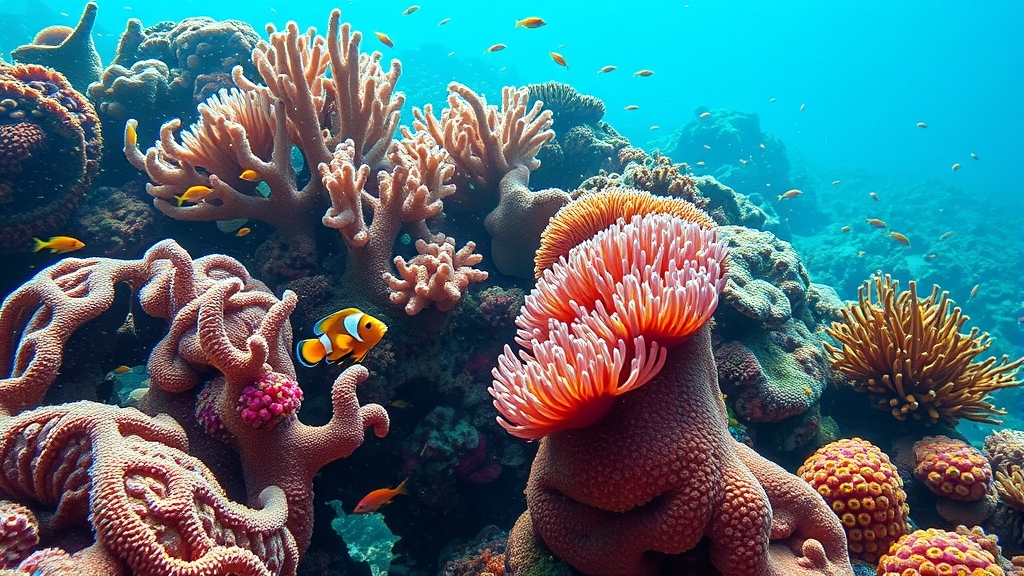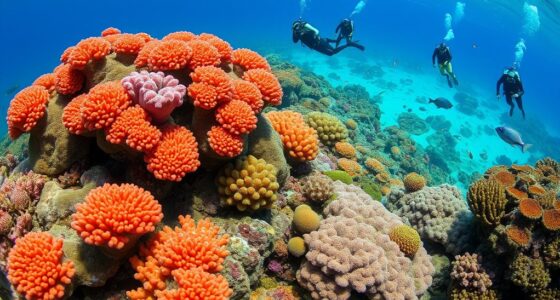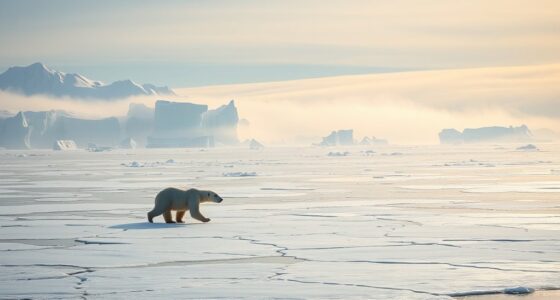Coral reefs are vibrant underwater ecosystems often called the ocean’s rainforests because of their rich biodiversity. They’re built by tiny animals called polyps that form complex structures, supporting thousands of marine species. Corals have a special relationship with algae called zooxanthellae, which help them thrive through photosynthesis. However, threats like climate change and pollution damage these delicate environments. If you want to explore how reefs sustain such life and how we can protect them, keep going.
Key Takeaways
- Coral reefs are vibrant ecosystems built by tiny animals called polyps, supporting vast marine biodiversity.
- They rely on mutualistic relationships with algae (zooxanthellae) for nutrients and growth.
- Reef health is threatened by climate change, leading to coral bleaching and ecosystem decline.
- Conservation efforts include protected areas, sustainable practices, and public education.
- Reefs are crucial for marine life, coastal protection, and local economies, making their preservation vital.

Have you ever wondered why coral reefs are often called the “rainforests of the sea”? It’s because they’re bustling ecosystems packed with life, diversity, and intricate relationships. At the heart of this vibrant environment is marine symbiosis, a fascinating partnership that keeps these reefs thriving. You see, corals themselves are tiny animals called polyps, but they rely heavily on a symbiotic relationship with microscopic algae known as zooxanthellae. These algae live inside the coral tissues, photosynthesizing sunlight into nutrients that nourish the polyps. In return, the coral provides the algae with a protected environment and access to sunlight. This mutualistic relationship is what fuels the rapid growth and stunning diversity of coral reefs. Without it, the reefs wouldn’t sustain the vibrant ecosystems that support thousands of marine species.
As you learn about coral reefs, it’s essential to understand that they face numerous threats, primarily from human activity. Climate change has caused ocean temperatures to rise, leading to coral bleaching, where corals expel their symbiotic algae and become vulnerable to disease. Overfishing, pollution, and destructive fishing practices also wreck havoc on these delicate habitats. That’s where reef conservation comes into play. By protecting reef environments, you help preserve the complex web of marine symbiosis that sustains these ecosystems. Conservation efforts include establishing marine protected areas, regulating fishing practices, and promoting sustainable tourism. These measures aim to reduce stress on reefs and promote their resilience against ongoing threats. Engaging in reef conservation isn’t just about saving pretty underwater scenery; it’s about maintaining the balance that supports countless marine species, including humans who depend on the ocean for food, livelihoods, and cultural identity.
You can contribute to reef conservation in many ways. Supporting organizations dedicated to marine protection and participating in local conservation initiatives make a difference. Educating others about the importance of coral reefs and the fragile relationships within them encourages broader awareness and action. Additionally, reducing your carbon footprint helps combat climate change, which is the biggest threat to these ecosystems. When you understand how marine symbiosis sustains coral reefs, you realize that protecting these ecosystems is about safeguarding the health of the entire ocean. Every effort counts, whether it’s advocating for stronger environmental policies or simply being mindful of your own impact. By doing so, you’re helping ensure that the rainforests of the sea continue to thrive for generations to come.
Frequently Asked Questions
How Do Coral Reefs Recover After Bleaching Events?
When coral reefs bleach, they lose their vibrant colors and essential symbiotic algae. You can help reefs recover by supporting efforts that boost coral resilience, such as reducing pollution and climate change. Recovery mechanisms like natural regeneration and new coral growth play critical roles. By protecting these environments and minimizing stressors, you enable reefs to bounce back more quickly, fostering healthier ecosystems for future generations.
What Are the Main Threats to Coral Reef Biodiversity?
Have you ever wondered what threatens the vibrant life beneath the waves? Pollution impacts, like plastic waste and chemicals, harm coral and marine species, while overfishing consequences reduce fish populations that keep reefs healthy. These threats disrupt the delicate balance of reef ecosystems, leading to loss of biodiversity. If we don’t address these issues, the colorful, bustling world of coral reefs could fade forever, taking countless species with it.
Can Coral Reefs Exist in Freshwater Environments?
You might wonder if coral reefs can exist in freshwater environments. Typically, corals are marine creatures, thriving in saltwater, but some non-marine corals, called freshwater corals, can survive in freshwater habitats. These freshwater corals are rare and different from their ocean counterparts. So, while most coral reefs are marine, a few non-marine corals adapt to freshwater environments, but they don’t form the large, diverse reefs you see in oceans.
How Do Scientists Monitor Coral Reef Health Long-Term?
Ever wonder how scientists keep tabs on the vibrant life of coral reefs? They use long-term monitoring methods like underwater surveys, satellite imaging, and water quality tests. By tracking coral growth and genetic diversity over time, they can spot signs of stress or decline. This approach helps them understand reef resilience and guide conservation efforts, ensuring these underwater rainforests thrive for generations to come.
Are There Artificial Reefs That Support Marine Life?
You’ll find that artificial reefs are designed to support marine life by mimicking natural habitats. They serve as marine habitat creation projects, attracting fish and other sea creatures, which helps boost local ecosystems. These reefs are often made from materials like concrete, metal, or old ships, providing safe spaces for marine species to thrive. Artificial reefs are a practical way to enhance biodiversity and promote sustainable fishing practices.
Conclusion
Now that you’ve learned about coral reefs, it’s clear they’re the ocean’s rainforests, full of vibrant life and delicate balance. Remember, these ecosystems rely on you to protect them—every small action counts, like reducing plastic waste or supporting marine conservation. Just like sailors of old charted new worlds, you can help safeguard these underwater treasures for future generations. So, immerse yourself with awareness and care; the reef’s survival depends on you.









